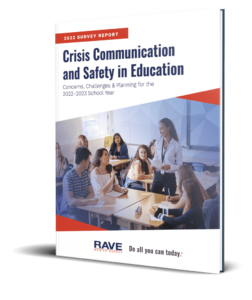
The past two years of COVID-19 restrictions have been a challenging time for students, staff, faculty and parents/guardians. Campus leaders are concerned about how the lingering effects of the pandemic will impact school communities going forward, especially if the right resources and safety measures are not put in place. To better understand these concerns, Rave Mobile Safety, provider of a critical communication and collaboration platform, fielded its second annual national survey of over 400 K-12 employees and over 380 higher education staffers in February 2022.
Key findings of the Crisis Communication and Safety in Education Survey include:
- Student mental health is the top safety concern for the 2022-2023 school year for K-12 respondents (61%) and the second-highest concern for higher education respondents (59%).
- Faculty and staff mental health is the third-highest safety concern for respondents from both K-12 schools (52%) and higher education institutions (44%).
- Concerns about active assailants on campus rose dramatically year-over-year for both K-12 respondents (+14%) and higher education respondents (+15%).
- K-12 survey respondents also shared increased concern about cyberbullying compared to 2021 (+12%), while higher education administrators expressed increased anxiety regarding crime (+20%) and severe weather events (+19%).
- To address these concerns, respondents on both the K-12 (43%) and higher education (39%) fronts are investing more heavily in mental health resources.
- For crisis communications, K-12 respondents indicated room for improvement in reaching staff (23%), and students and parents/guardians (26%), while higher education respondents had less concern in reaching staff (16%), and students and parents/guardians (15%).
Higher Education
More so than K-12 schools, institutions of higher education still list COVID-19-related safety measures as the top concern for next year (71%), followed by student mental health (59%) and faculty/staff mental health (44%). Additionally, concerns over crime increased by 20% year-over-year, and concerns over active assailants increased by 15%, both of which are likely related to the anticipated uptick in mental health needs next year.
Nearly half of survey takers (46%) are more concerned about active assailants and violent acts than they were prior to the beginning of the pandemic. As with K-12 schools, social media again increased anxiety about this kind of violence on campus amongst respondents. Threats on social media platforms have contributed meaningfully to how survey respondents (69%) think about campus safety.
To address leading safety concerns, higher education institutions are investing further in COVID-19-related safety resources (45%) and mental health resources (39%). They are also providing greater access to health and wellness services (38%) while ramping down certain activities, such as daily health checks for students.
Respondents in higher education experienced fewer crisis communication challenges than their K-12 counterparts. However, 16% still have a hard time reaching staff, and 15% struggle to reach students, parents and/or guardians amid crises.
K-12 Schools
The pandemic brought on periods of isolation and stress to students everywhere, bringing mental health concerns to the forefront of challenges for K-12 schools. According to the survey, two of the top three safety concerns for respondents are student (61%) and faculty/staff (52%) mental health. Anxiety around potential situations involving an active assailant saw a major rise (+14%), as did cyberbullying (+12%).
One area of concern that grew dramatically this year was the potential for future violent situations on campuses. More than half of respondents (55%) are more concerned about active assailants and violence on campus than they were before the pandemic. Social media is also complicating matters, as many respondents are following how recent waves of threats on TikTok and similar platforms are affecting schools. Nearly 80% of respondents acknowledged that these occurrences have contributed to their concern for campus safety.
Unsurprisingly, investing more in mental health resources (43%) emerged as the top intervention for next year – an 8% increase as compared to last year’s report. Currently, only half (50%) of schools believe they have adequate mental health resources to support students.
While these threats remain top of mind, many K-12 respondents acknowledged that they struggled to communicate effectively with all key parties. These challenges include issues reaching and notifying students and/or parents/guardians (26%) and issues reaching and notifying staff (23%).
Learn more about: 2022 Crisis Communication and Safety in Education Survey.
